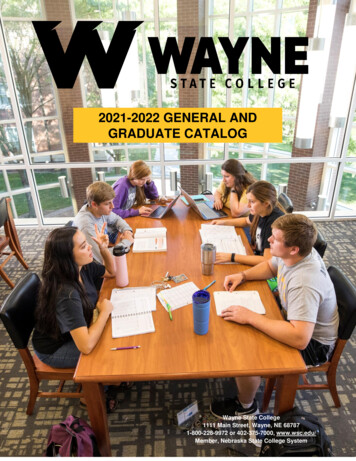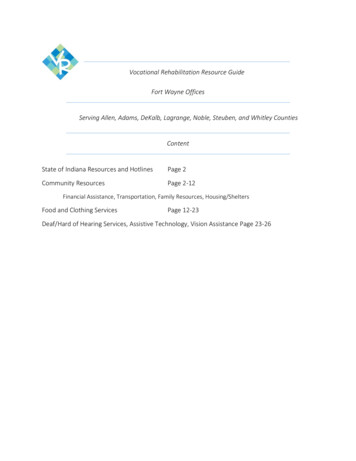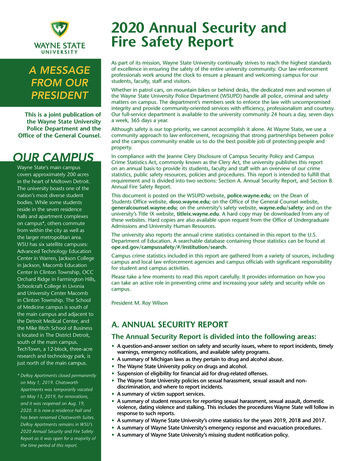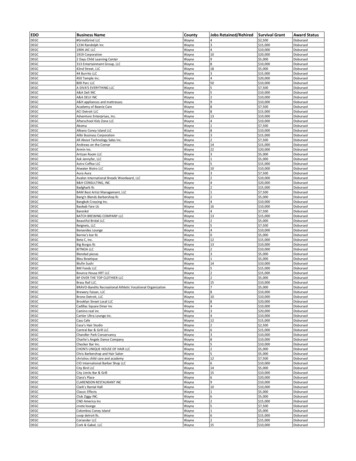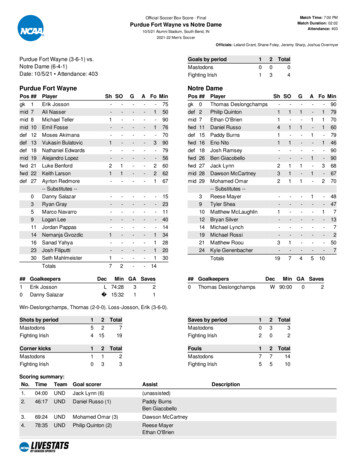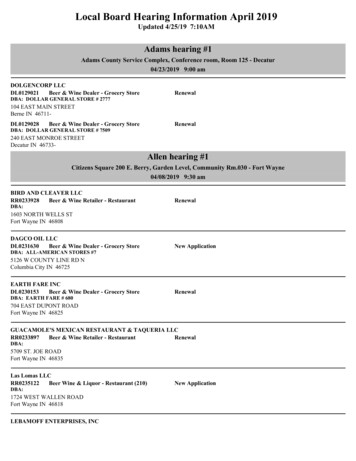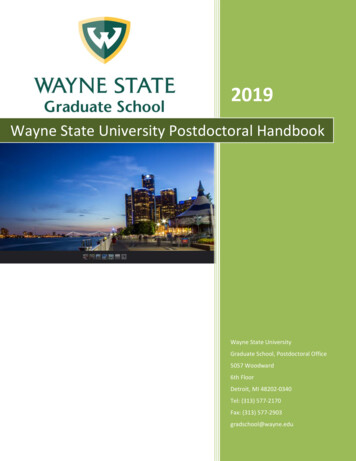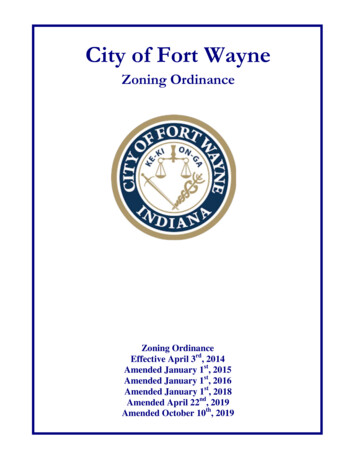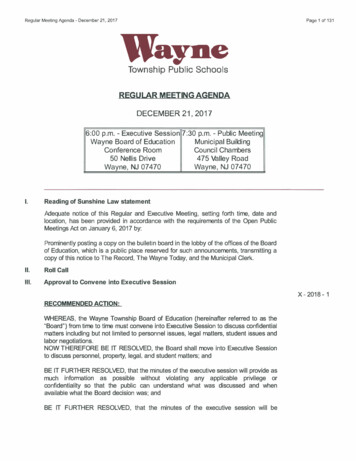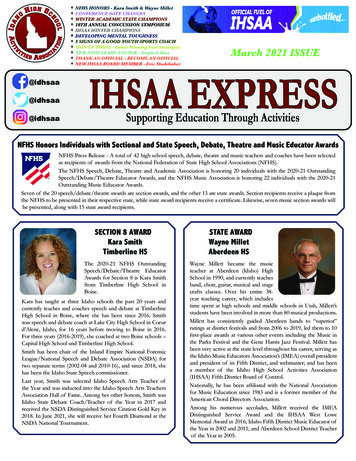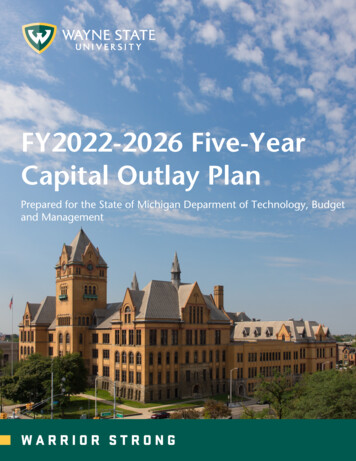
Transcription
Table of ContentsMission StatementDiversity and InclusionPage 1Page 1Instructional ProgrammingExisting Academic ProgramsUnique Characteristics of Wayne State’s Academic MissionResearch AccomplishmentsEconomic Development Impact of Current/Future ProgramsWayne State University Research and Technology Park (TechTown)Page 2Page 2Page 3Page 4Page 6Page 8Staffing and EnrollmentStaffingEnrollmentAdmissions InitiativesStudent-to-Faculty RatiosCurrent Class SizeEnrollment and Graduation Patterns over the Past Six YearsExtension Center Summary & Web Class ReportPage 9Page 9Page 10Page 11Page 12Page 12Page 14Page 16Facilities AssessmentWSU Campus Housing DemandFunctionality of Existing Structures, Deferred Maintenance and Facilities ConditionUtilities and Energy ManagementSustainability PathFacilities and Land UseBuilding and Classroom Utilization RatesMandatory Facilities StandardsBond StatusPage 17Page 17Page 18Page 19Page 20Page 21Page 21Page 22Page 23Implementation PlanCapital Planning and PrioritiesPage 24Page 24AppendicesAppendix A: Capital ProjectsAppendix B: Buildings by AgePage 25Page 26Page 27
Wayne State UniversityFY2022-2026 Five-Year Capital Outlay Plan10/20/2020I. Mission StatementWayne State University’s mission, as stated in the Distinctively Wayne State University Strategic Plan2016-2021, is the creation and advancement of knowledge that results from preparing a diverse studentbody to thrive and positively impact local and global communities. To achieve this vitally importantmission, it is critical that we modernize and improve our physical infrastructure environment to supportour strategic focus on student success and teaching excellence, two of the key focus areas in our StrategicPlan.Diversity and InclusionDiversity and inclusion are woven through the mission, vision, values, and strategic focus areas of WayneState’s strategic plan. This commitment was actualized with the establishment of the Office of Diversityand Inclusion and the Office of Multicultural Student Engagement in winter of 2015. Wayne State offersan immersive educational experience where students work alongside people from different countries,cultures and socioeconomic backgrounds reflective of the city of Detroit, the region and state, and theworld. With the most diverse student body in Michigan, Wayne State students gain a distinct advantageas they prepare to build successful careers in the complex global marketplace.The Wayne State Office of Diversity and Inclusion is a unique resource dedicated to supporting students,faculty and the entire university community. Led by the Associate Provost for Diversity and Inclusion/ChiefDiversity Officer and home to the Office of Multicultural Student Engagement, this committed group ofindividuals is focused on sustaining Wayne State's inclusive campus and can provide assistance on anumber of issues. In 2018, under the leadership of the Associate Provost, the first ever diversity campusclimate study was initiated to learn more from the campus community about how they experience theclimate for diversity and inclusion-related issues.In July of 2020, Wayne State’s President M. Roy Wilson established and charged the Social Justice ActionCommittee (SJAC)—seven working groups created to address implicit bias and systemic racism throughexamination of policies, procedures, and practices throughout the campus. The groups include: the hiringand retention of diverse faculty and staff, student access and success, policing, and other critical areas offocus. Each SJAC working group will offer recommendations to the university leadership on how to makechanges in various systems and structures to enhance diversity, equity, and inclusion across the university.The Wayne State Office of Diversity and Inclusion and the Office of Multicultural Student Engagementcontinue to provide leadership and support to the campus through initiatives designed to build andsustain a more inclusive and equitable campus community.1
Wayne State UniversityFY2022-2026 Five-Year Capital Outlay Plan10/20/2020II. Instructional ProgrammingExisting Academic ProgramsWayne State University is a comprehensive research university with thirteen schools and collegesadministering approximately 350 academic programs including bachelor’s, master’s and doctoraldegrees, as well as professional programs and postbaccalaureate, graduate and specialist certificates,many of which rank in the top tier nationally. The university currently enrolls 26,251 students. Sixextension centers across southeastern Michigan provide access for residents to a wide selection of offcampus courses. The university is a significant and influential force in metropolitan Detroit’s educationaland cultural landscape, and TechTown, the 43-acre research and technology park that the universitysupports, has made it a major player in Michigan’s economic turnaround.The university educates significant number of Michigan’s youth and prepares them for productive careersin the state. In Fall 2020, 87% of our undergraduates are from the tri-county (Wayne, Oakland, andMacomb) area (15,224 out of 17,513 undergraduates), and 65% of graduate students and 62% ofprofessional students are from the tri-county area. Overall, 79.4% of our Fall 2020 student body are fromthe tri-county area, while 91% of the overall student body are from Michigan. Approximately 76.6 percentof Wayne State graduates reside in Michigan to provide the highly educated workforce necessary totransform and power Michigan’s economy in the twenty-first century.Wayne State University graduates serving the citizens of Michigan have advanced professional training inbusiness; engineering; education; law; pharmacy and health sciences; medicine; nursing; social work; fine,performing and communication arts; liberal arts; and the basic sciences. Every day, our graduates play acritical role in Michigan life, from local physicians, teachers and attorneys to scientists and engineersworking in the latest high-tech spin-off companies.Figure 1 illustrates the University’s fall 2019 and 2020 enrollment by headcount and degrees awardedfrom July 1, 2018 to June 30, 2019. These Figures, and all subsequent Figures, exclude graduate medicaleducation students.2
Wayne State UniversityFY2022-2026 Five-Year Capital Outlay Plan10/20/2020Figure 1: 2018-2019 Degrees Awarded and 2020 Enrollment by CollegeSchool or CollegeFall 2019EnrollmentSchool of BusinessCollege of EducationCollege of EngineeringCollege of Fine, Performing & Comm. ArtsGraduate SchoolLaw SchoolLiberal Arts & SciencesSchool of Information SciencesSchool of MedicineCollege of NursingPharmacy and Health SciencesSchool of Social 1,6461854142464564926,700Fall 488397795426,251Source: Office of Institutional Research and AnalysisUnique Characteristics of Wayne State’s Academic MissionWayne State University prides itself on its excellent faculty who reach students through their classroomand online teaching, practical training, and mentoring, engage in pioneering research, and participate innumerous activities within the broader community. Academic excellence and innovative research arecentral to our mission and a primary reason why graduate and undergraduate students alike choose toattend the university. We are one of the 50 largest public universities in the nation, and we have receivedthe Carnegie Foundation's highest classifications for research and community engagement, with annualresearch expenditures of more than 238 million. With the University of Michigan and Michigan StateUniversity, we participate in the University Research Corridor, that generates 95 percent of research inthe state and supports economic growth throughout Michigan. Wayne State is also one of Detroit's largestemployers: with a nearly 2.5 billion economic impact in the metro Detroit area, the university is a drivingforce behind the city's resurgence.From medicine and mechanical engineering to graphic design and geology, the university’s facultymembers are renowned for innovation and expertise in their fields, crafting hands-on curricula to takestudents out of the classroom and into the real world. Wayne State University is increasingly known forinterdisciplinary research in areas such as urban health sciences and disparities, theenvironment, entrepreneurship and data analytics, human services and education, manufacturing, publicpolicy and the law, language and the arts. Whether in the lab or on the stage, the faculty has a measurableimpact locally in our own neighborhood, regionally and within the state, and around the world.3
Wayne State UniversityFY2022-2026 Five-Year Capital Outlay Plan10/20/2020University Program Rankings: Top 1.4 percent of universities worldwide — Center for World University Rankings Best business school — Princeton Review No. 2 medical institution for research in Michigan — U.S. News and World Report Top 100 law school, second in Michigan — U.S. News and World Report One of the nation's best law schools for bar prep – The National Jurist Top-ranked physician assistant program in Michigan — U.S. News and World Report Social work program in the country's top 20 percent — U.S. News and World Report Nursing-anesthesia program ranked in the country's top 20 percent —U.S. News and World ReportFacilities and projects that provide community impact: IBio, a 90 million facility dedicated to eliminating health disparities in Detroit TechTown, Detroit's most established business accelerator and incubator Hilberry Theatre, the nation's first graduate repertory company Technology assistance, helping launch 800 student and faculty innovators’ patent applicationssince 2009 Wayne Law pro-bono legal services, assisting 100 clients annually Blackstone Launchpad business assistance, helping more than 150 student venturesResearch AccomplishmentsWayne State University is a preeminent public research university in an urban setting with faculty whoconduct innovative research yielding groundbreaking discoveries that impact everyday lives. Through amultidisciplinary approach to research and education, and ongoing collaboration with government,industry and other institutions including our University Research Corridor partners – the University ofMichigan and Michigan State University – and the TechTown research and technology park, the universityseeks to expand knowledge, enhance economic growth and improve the quality of life in the city ofDetroit, state of Michigan, and throughout the world.Research at Wayne State University continues to gain momentum, including an increase in totalextramural research funding from 150 million in FY2013 to 313 million in FY2019, and nearly a 21%increase in federal extramural research funding. Research expenditures have followed this upward trend.Expenditures under research grant and contract awards have increased by over 9% since 2016 with a totalof 244 million in FY2019. According to the NSF’s 2017 Higher Education Research and DevelopmentSurvey (the most recent published ranking) Wayne State University ranked 69th among 400 publicuniversities and 99th out of more than 3,500 U.S. colleges and universities.The innovative research conducted by our faculty and research staff are illustrative. Dr. Kamran Avanakiin the College of Engineering conducts research funded by the National Institutes of Health to develop anovel point-of-care 3D neonatal photoacoustic tomography to improve the detection and measurementof hypoxic-ischemic in neonates without the need for sedation, radiation or radionuclides. This will allowfor earlier treatment in infants that could circumvent neural complications and improve functionaloutcomes from cerebral palsy and cognitive impairments.Dr. Weisong Shi, associate dean of research in the College of Engineering leads a team of researchers todesign and implement a risk- prediction and update system so that individuals and various entities can beaware of the potential risk of infection (such as COVID-19) when individuals or groups are traveling locally,4
Wayne State UniversityFY2022-2026 Five-Year Capital Outlay Plan10/20/2020nationally or abroad. The team seeks to derive a system that can assess infection risk at different levels,such as individually, at large-event or institutional levels. The project has been funded with a NationalScience Foundation RAPID grant and also a Google Cloud Platform grant.The School of Medicine’s Microscopy, Imaging and Cytometry Resources Core located at the Barbara AnnKarmanos Cancer Institute received a R50 grant from the National Cancer Institute that seeks to supportand enhance peer-reviewed funded research activities at Wayne State and Karmanos through advancedcytometry, as well as cellular, tissue and animal imaging and analysis. Dr. Kamiar Moin from theDepartment of Pharmacology and his colleagues will provide expertise in analytical methodsdevelopment, technology development and validation, and imaging and cytometry study design. Dr. Moinand his staff are internationally recognized experts in imaging and cytometry.A partnership between Wayne State’s School of Medicine, College of Engineering and the PerinatologyResearch Branch has secured a major grant from the National Institutes of Health to study biomarkers forspontaneous preterm delivery, the leading cause of infant mortality worldwide. The study, led by Dr.Mohammad Mehrmohammadi of Wayne State University’s Department of Biomedical Engineering and ofthe Department of Obstetrics and Gynecology, plans to develop a clinically translatable technology toovercome the limitations of existing sonography procedures to identify patients at risk of preterm birthby combining three modalities (two-dimensional ultrasound, elastography and photoacoustic) into asingle device to acquire a wide range of functional and molecular information about cervical ripening.The School of Medicine is also exploring how a common piece of the immune system contributes to avariety of inflammatory diseases. With the help of a major grant from the National Institutes of Health,Dr. Yuan He of the Department of Biochemistry, Microbiology and Immunology will study a criticalcomponent of the innate immune system that controls the secretion of pro-inflammatory cytokinesinterleukin in response to infection and tissue damage. The goal of the project is to better understandhow the NLRP3 inflammasome is activated so that it might guide the development of novel therapies fortreatment of several inflammatory disorders including gout, diabetes and Alzheimer’s disease.The Eugene Applebaum College of Pharmacy and Health Sciences is leading a team of researchers tounderstand the causal relationships between diabetes, obesity and nonalcoholic fatty liver disease –common diseases that can lead to inflammatory and fibrotic liver, called nonalcoholic steatohepatitis, aswell as liver cirrhosis. The team led by Dr. Wanqing Liu of the Department of Pharmaceutical Sciences,have done the largest-to-date data analysis, with their study having important implications for diseaseclassification, diagnosis and drug development. It also highlighted the importance of the development ofprecision medicine for both prevention and treatment of these diseases. It also found that many type-2diabetes patients may be misdiagnosed, and their treatment should be altered accordingly.The Department of Physics in the College of Liberal Arts and Sciences received a major grant renewal fromthe National Science Foundation for their JETSCAPE collaboration – a multidisciplinary team of physicists,computer scientists and statisticians from 13 institutions that is creating an open-source statistical andcomputational software to help scientists better understand high energy nuclear collisions. Dr. AbhijitMajumder of the Department of Physics is leading the Wayne State team and believes that the researchwill broaden and evolve into a much more elaborate simulator that could be applied to a variety of futureexperiments, bringing high-energy nuclear experiments under a single simulation umbrella, that allowsfor a cross-pollination of ideas between different experiments.5
Wayne State UniversityFY2022-2026 Five-Year Capital Outlay Plan10/20/2020A team of Wayne State social scientists in the College of Liberal Arts and Sciences received a NationalScience Foundation RAPID grant to examine how work, family and health among dual-income coupleshave changed within the context of COVID-19. Led by Krista Brumley of the Department of Sociology, theteam will examine work-family conflict under unprecedented circumstances to examine how couplesmanage the competing demands of work and family. It will also illuminate the effects of work on familyconflict and could encourage employers to reconsider their restrictive work policies to offer more optionsto their workers.The College of Nursing is playing a critical role in providing improved care and comfort in patients withdyspnea – or shortness of breath – that can cause discomfort in people approaching the end of life. Thestudy led by Dr. Margaret Campell of the College of Nursing, is dedicated to research that furthers theability of physicians and nurses to better assess respiratory distress in patients who can no longer selfreport dyspnea by further developing the Respiratory Distress Observation Scale which is now used byclinicians around the world. Dr. Campbell and her team’s goal is to develop a global standard foraddressing treatment of dyspnea during ventilator withdrawal. The study is funded by the NationalInstitutes of Health.These groundbreaking research projects and many more are just examples of the great impact our facultyand research staff have on improving the quality of life around the globe.Economic Development Impact of Current/Future ProgramsWayne State University’s impact on Southeast Michigan is substantial, estimated by the AndersonEconomic Group to be over 2.5 billion per year. The large numbers of alumni who remain in the areaafter graduation contribute significantly to the region’s well-being through their professional and personalaccomplishments, community activities and financial resources. Additionally, the University is among thelargest employers in the City of Detroit with nearly 7,500 full- and part-time faculty and staff.In fiscal year 2019, the university spent nearly 594 million for compensation, wages, and fringe benefits.The university awarded more than 351 million in financial aid (federal, institutional, private, outside andstate) to 33,680 undergraduate and graduate students, which translates to an average of 10,429 peraward. Expenditures on supplies and services in FY18 exceeded 198 million, with 71.4% of all invoicespaid to Michigan-based companies.The university spent over 224 million in research and development during fiscal year 2019. In fiscal year2019, 62 new patent applications were filed, and 43 total patents were issued (U.S. and foreign).Furthermore, the university spent 787 million to file and maintain all of its patent applications and issuedpatents and received 715,247 in revenue from license and startup companies.Through fiscal year 2018, the university's portfolio contained over 550 technologies, including more than400 pending and issued patents. More than 130 of those technologies were licensed, with 32 licensed toMichigan-based companies. The university has assisted in the start-up of more than 40 companies basedon university intellectual property with the majority of those startups located in Michigan.Wayne State University is committed to encouraging an entrepreneurial culture and establishinginfrastructure that supports the creation of new companies. The Wayne State University InnovationStudio powered by TechTown has helped launch nearly 200 businesses that have generated revenue or6
Wayne State UniversityFY2022-2026 Five-Year Capital Outlay Plan10/20/2020hired employees since 2011, while the Goldman Sachs 10,000 Small Businesses program has graduated575 second-stage small businesses from across Michigan, which employ more than 8,700 people and havegenerated more than 900 million in revenue. Approximately 70% of these businesses increased revenuesafter completing the program, and 45% created new jobs. TechTown Detroit has served 2,325 companies,which leveraged nearly 145 million in start-up capital and contributed 1,546 jobs to the local economyfrom 2007 to 2018.Transformations in the Wayne State neighborhood include: 178 businesses have opened or expanded in the Midtown, TechTown and New Center districtssince 2014; another 77 are scheduled to open or expand in by the end of 2020. The Live Midtown program attracted 1,202 new residents to the area and retained 913. Thefinancial impact of the program is estimated at over 22 million. The Stay Midtown incentive, designed to help cost-burdened households currently residingMidtown remain in the area, has provided assistance to 128 households since 2016. Residential occupancy for rental housing has been at or above 98% since 2014. 2,078 residential units were recently completed ( 787 million invested); 1,606 are underconstruction ( 720 million invested); and another 2,051 are in the construction pipeline ( 1.1billion soon-to-be invested). Midtown has seen a 55% decline in major crime since 2009, due in large part to Wayne StateUniversity’s Police Department and its community policing activities.Wayne State University is committed to be a catalyst for economic growth in the city. Initiatives include: The university completed a comprehensive space utilization analysis and adopted a new campusmaster plan with a 10-year planning horizon, the Wayne Framework. The university is one of 12 institutions partnering in an international design competition andplanning process that asks students to consider how technologies can be used to further themissions of cultural institutions and help them better coordinate, cooperate, and collaborate witheach other to enhance the experiences of visitors to their institutions and to the wider culturaldistrict. Construction was completed on the Anthony Wayne Drive apartments in 2019, a 111 millionmixed-use building with 840 new dorm beds and 86,500 square feet of retail space. The university acquired the NextEnergy building in 2018 for 6.6 million. The new IndustryInnovation Center (I2C) will be a space where university and industry partners collaborate. Woodward Warren Park features landscaping, seating, a welcome kiosk, solar panels andmarketplace lighting.7
Wayne State UniversityFY2022-2026 Five-Year Capital Outlay Plan 10/20/2020The university continues to promote and make investments in transportation and mobilitysolutions including the QLINE, MoGo, DDOT and SMART.Wayne State University Research and Technology Park (TechTown)TechTown is Detroit’s entrepreneurship hub. As the city’s most established business accelerator andincubator, TechTown provides a powerful connection to a broad network of resources, catalyzing entirecommunities of entrepreneurs to energize the local economy. It offers both tech and place-basedeconomic development programs, as well as coworking, office, meeting and event space.TechTown is a 501(c)(3) nonprofit and is located within the Woodward Technology Corridor SmartZone,on the northern edge the university’s main campus. The TechTown building is located one block fromWayne State University’s Integrative Biosciences (IBio) Center and across the street from the NextEnergybuilding, which the university acquired in 2018. Wayne State University is partnering with TechTown totransform the NextEnergy building into the Wayne State Industry Innovation Center (I2C), a facility foruniversity and industry collaboration and research, with a focus on cyber physical systems including cybersecurity, connected and autonomous vehicles, and smart city technologies.In this growing neighborhood, Wayne State University’s students and faculty work alongsideentrepreneurs at TechTown to refine new generations of businesses. TechTown not only contributessignificantly to the university’s research capital but also strengthens and diversifies the region’s economy.The relationship with TechTown highlights one of Wayne State University’s greatest strengths, its abilityto partner with industry and government for the good of the populations the university serves. TechTownfosters a community of engaged, connected, and better served entrepreneurs, who will accelerate theregion’s transition into an innovation-based economy.8
Wayne State UniversityFY2022-2026 Five-Year Capital Outlay Plan10/20/2020III. Staffing and EnrollmentStaffingFigure 2: Full Time Employee Count by HR Equal Employment Opportunity (EEO) CategoriesClerical and SecretarialExecutive/Admin and ManagerialFacultyOther ProfessionalService/MaintenanceSkilled 01,7282,0002,1772,5002,198Technical and 03452711,000FALL 2014FALL 2015FALL 2016FALL 2017FALL 2018FALL 2019Source: Office of Institutional Research and Analysis9
Wayne State UniversityFY2022-2026 Five-Year Capital Outlay Plan10/20/2020Figure 3: Part Time Employee Count by HR Equal Employment Opportunity (EEO) CategoriesExecutive/Admin and ManagerialFacultyGraduate AssistantOther ProfessionalsService/MaintenanceSkilled CraftsTechnical and 00740858100086197310081200914831Clerical and Secretarial600FALL 2016FALL 20186011560199139FALL 201713301131051125FALL 2015810118FALL 201416182012241959200139400FALL 2019Source: Office of Institutional Research and AnalysisEnrollmentDespite the global COVID-19 pandemic, WSU is demonstrating strong enrollment and student successoutcomes, particularly for undergraduate students. Our entering class of 3,039 full-time freshman is thelargest in WSU history, surpassing the previous record set in 2018. Total enrollment for undergraduatesis down 0.7%, in part because of the university’s improved graduation rates, described below. Decreasesin transfer students, observed nationally also contributed to this slight decline. Total graduate andprofessional enrollment is down 5.0%, reflecting in large part barriers to international student enrollment;nonetheless, the decline here is less than many of the university’s peers. Wayne State University’s overallFall 2020 enrollment was down 2.2%, from 26,844 to 26,251; but total credit hours are up 0.1%, indicatinga stronger revenue projection as well as reflecting stronger student success outcomes.The Student Success Initiative has overhauled the student experience and is drawing national attentionfor our positive results over the past decade. As a result of this effort, our 6-year graduation rate roughlydoubled from 26% in 2011 to 52% in 2020, the fastest rate of improvement in the nation for large publicuniversities over much of this time. Our commitment to continued improvements in student success is anintegral part of the university. Gains in student success have been achieved across the undergraduatepopulation, with dramatic increases in the 6-year graduation rates for Black students (8% to 25%), Latinxstudents (18% to 35%), first-generation students (18% to 43%), and low-income students (16% to 45%).Similar improvements hold for 4-year and 5-year graduation rates; thus, we expect continuedimprovement over the coming years.Concurrent gains in other measures of student success point to academic and learning gains. Studentsare completing 26 credits (on average) during their first two semesters, compared to 21 a decade ago.10
Wayne State UniversityFY2022-2026 Five-Year Capital Outlay Plan10/20/2020This trend holds for students of color, first generation students and low-income students as well, althoughat decreased levels. For example, Black students completed 16 credits on average during their first falland winter in 2011, increasing to 23 on average today. (White students showed an increase of three credithours earned over the same time period.)Students are passing 92% of their courses during the first year, compared to 80% a decade ago, anotherpattern which holds for first-generation students, low-income students, and students of color. The gainsin the percentage of courses passed and the number of credits earned during the first year for thesegroups exceeds that of majority/non-first generation/non-low-income students. Thus, gaps are narrowingon these metrics. For example, in 2011, Black students passed 68% of their first-year courses on average;today it is 84%. (White students improved from 91% to 93% over the same time period.)When the COVID-19 pandemic began to affect colleges and universities in March 2020, Wayne StateUniversity made strong commitments to our students’ learning and to their health, as well as the healthof our entire campus community and the city. Our transition to remote and online instruction wassmooth; we were particularly pro-active in our outreach to students at that time to ensure that they wereable to participate successfully in the new forms of delivery.Our restart planning process was more proactive and conservative than many other universities. Thus,we have not had the abrupt reversals of course that some colleges and universities have had, and we havevery few COVID cases among students. The global pandemic has not appeared to have stalled our studentsuccess improvements. First to second year retention from 2019 to 2020 was 82%, the largest since webegan recording and reporting retention numbers. Retention numbers are also up across very nearlyevery sub-population as well.Nonetheless, educational disparities remain for Black and Latinx students, first generation students, a
Wayne State University 10/20/2020 FY2022-2026 Five-Year Capital Outlay Plan 1 I. Mission Statement Wayne State University's mission, as stated in the Distinctively Wayne State University Strategic Plan 2016-2021, is the creation and advancement of knowledge that results from preparing a diverse student body to thrive and positively impact local and global communities.
